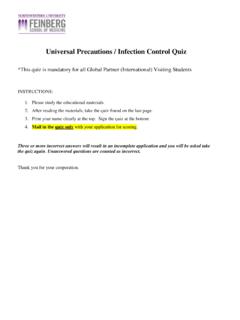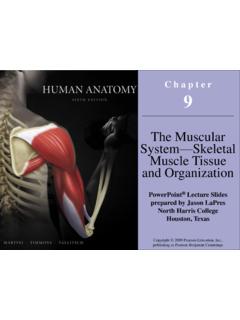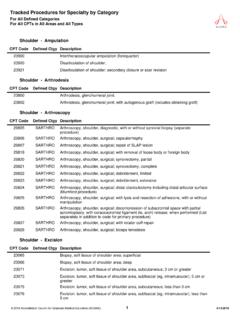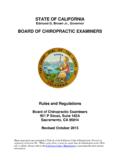Transcription of TISSUE FREEZING METHODS FOR CRYOSTAT SECTIONING
1 TISSUE FREEZING METHODS FOR. CRYOSTAT SECTIONING . Basic TISSUE FREEZING METHODS Preparing TISSUE for FREEZING Then a quick overview of MHPL CRYOSTAT SECTIONING Techniques: Using The Brush;. Using The Anti-Roll Plate;. Speaker: Donna J. Emge, HT-ASCP, MHPL Manager Preparing TISSUE For FREEZING TISSUE for FREEZING should be frozen or fixed as promptly as possible after cessation of circulation to avoid morphological distortions and damage due to: TISSUE drying artifact. Autolysis - The destruction of tissues or cells by the action of substances, such as enzymes, that are produced within the organism. Also called self-digestion. Putrefaction - Decomposition by microorganisms. WHY SNAP FREEZE OR FIX AND.
2 CRYOPROTECT FOR FREEZING ? Slow FREEZING can cause distortion of TISSUE due to ice crystal formation that replaces the architecture with a Swiss Cheese effect. The object is to freeze so rapidly that water does not have time to form crystals and remains in a vitreous form that does not expand when solidified. Brain Skeletal Muscle FREEZING artifact in sections of Brain, Muscle, and Spleen SHORT ARTICLE ON THE SUBJECT OF. WATER CRYSTAL FORMATION: FREEZING BIOLOGICAL SAMPLES . Charles W. Scouten & Miles Cunningham d%20 Techniques%20 FREEZING % METHODS OF TISSUE FREEZING . 1. Fresh TISSUE FREEZING TISSUE is in OCT and flash frozen fresh. 2. 4% PFA fixed, sucrose cryoprotected TISSUE FREEZING .
3 TISSUE is in OCT and may be frozen using dry ice or the flash frozen method. 3. Enzyme study TISSUE FREEZING Often used for fresh muscle TISSUE . A fresh frozen method with no OCT. matrix. TISSUE protrudes from a Tragacanth or other support medium. MHPL Protocols for these METHODS are included in your workshop folder. WHY NOT JUST USE LIQUID NITROGEN? AFTER ALL: Liquid nitrogen is one of the coldest liquids routinely available and it does not mix with TISSUE .. It Boils this creates a vapor barrier that causes FREEZING in a slower, unpredictable pattern. TISSUE and OCT often cracks due to this unpredictable FREEZING pattern. Review the article: FREEZING BIOLOGICAL SAMPLES . Charles W.
4 Scouten & Miles Cunningham GETTING STARTED: Before you dissect the animal - organize and set-up: Before you dissect the animal - organization and set-up: Choose appropriate FREEZING method - and depending on the method prepare liquid nitrogen, isopentane, dry ice. Label ahead of time - cryo molds, aluminum foil, specimen bags while at room temperature. Covered Foam cooler with crushed dry ice . to temporarily hold frozen samples as you work. Tools & other supplies - OCT, or Tragacanth, forceps, small labeled weigh boats or small labeled petri dishes. FRESH TISSUE FREEZING . Pros Fastest of all METHODS . Excellent for IHC, IF, ISH. No antigen retrieval required since no cross-linking fixative.
5 Often easiest to section depending upon TISSUE . Cons Poorest morphology. Prone to FREEZING artifact must be snap frozen. ISH integrity extreme clean techniques required or RNA will be rapidly and easily degraded. PREPARING FRESH TISSUE FOR FREEZING . (Not for enzyme study method). Acclimate TISSUE to OCT - cover freshly dissected TISSUE for a few minutes in OCT in a labeled small petri dish or small weigh boat. Transfer and orientate in fresh OCT in a labeled Cryomold with just enough OCT to cover the TISSUE . Avoid bubbles in the OCT especially near the TISSUE . SECTIONING surface - is the bottom of the Cryomold. Begin FREEZING . Fresh TISSUE FREEZING Procedure: A metal beaker is filled 2/3 with Isopentane and placed in a Dewar of Liquid Nitrogen enough to come up to about 1/3 of the metal beaker.
6 Prepare at least 10 minutes before FREEZING sample. With 12 inch forceps freeze the cryo mold prepared sample in the clear portion of isopentane do not fully submerge. Avoid block cracking - when there is still a small drop size of unfrozen OCT. transfer sample to covered foam cooler of dry ice while continuing on to other samples. Temporarily store frozen samples in a covered foam cooler of dry ice while continuing to freeze other samples Wrap individual samples in labeled foil, seal in a plastic bag, place in a freezer box . Store at -80 C. 4% PFA FIXED, SUCROSE. CRYOPROTECTED TISSUE FREEZING . Pros Excellent morphology compared to other METHODS . May use a slower freeze in crushed powder dry ice alone, slush of dry ice and 100% alcohol, or in a beaker of isopentane surrounded by dry ice - without incurring FREEZING artifact or block cracking.
7 Any of the FREEZING METHODS discussed can be used. Good for most IHC, IF and ISH. Cons Time consuming Most IHC will require antigen retrieval. Although the fixative cross-linking is protective for ISH. techniques there is some RNA degradation. PREPARING FIXED, SUCROSE. CRYOPROTECTED TISSUE . 4% PFA transcardial perfuse animal. Drop fix in 4% PFA for a few hours to O/N. 15% sucrose in 1 XPBS until TISSUE sinks. 30% sucrose in 1 XPBS until TISSUE sinks. SUCROSE CRYOPROTECTED TISSUE FREEZING . (Not for enzyme study method). Acclimate TISSUE to OCT - cover freshly dissected TISSUE for a few minutes in OCT in a labeled small petri dish or small weigh boat. Transfer and orientate in fresh OCT in a labeled Cryomold with just enough OCT to cover the TISSUE .
8 Avoid bubbles in the OCT especially near the TISSUE . SECTIONING surface - is the bottom of the Cryomold. Begin FREEZING . FIXED, SUCROSE CRYOPROTECTED TISSUE FREEZING . A metal beaker is filled with isopentane, placed in a foam cooler or laboratory ice bucket and surround with crushed dry ice. Add a few pieces of dry ice to the isopentane and wait until boiling stops. Add more isopentane if necessary. With 12 inch forceps freeze the cryo mold prepared sample in the isopentane do not fully submerge. Alternatively: Freeze cryomold prepared sample by surrounding it in finely powder crushed dry ice alone, or in a dry ice methanol or 100% Ethanol slurry. Transfer frozen sample to a covered foam cooler of dry ice while continuing on to other samples.
9 Wrap all samples in labeled foil, place in a bag sealed bag, in a freezer box. Store at -80. ENZYME STUDY TISSUE FREEZING . Pros Excellent for Enzyme histochemistry and Immunohistochemistry studies. Best method for muscle TISSUE . Cons Advanced skill needed for SECTIONING no supportive OCT matrix. Anti-roll plate better than brush technique. Time and technique skill to prepare. Extremely susceptible to any freeze thaw leading to loss of morphologic detail in muscle or brain TISSUE . ENZYME STUDY METHOD. TISSUE PREP FOR FREEZING . Organize and set up: ENZYME STUDY METHOD PREP FOR TISSUE FREEZING . Prepare a small pyramid of thick Tragacanth paste on a small piece of cork. Make a small hole in the Tragacanth paste pyramid.
10 ENZYME STUDY METHOD PREP FOR TISSUE FREEZING . Gently remove any surface moisture from TISSUE with fresh TISSUE wipe. Place 1/8 to of the TISSUE in a hole at top of pyramid, leaving the rest stick out above the tragacanth. Seal edges of tragacanth to the TISSUE . ENZYME STUDY TISSUE FREEZING . Procedure: A metal beaker is filled 2/3 with Isopentane and placed in a Dewar of Liquid Nitrogen enough to come up to about 1/3 to of the metal beaker. Prepare at least 10 minutes before FREEZING sample. Hold the cork/tragacanth/sample with 12 forceps and submerge sample side down completely into the isopentane for 10 to 20 seconds. ENZYME STUDY TISSUE FREEZING . Transfer sample to covered foam cooler of crushed dry ice or immediately to a -80 freezer.







